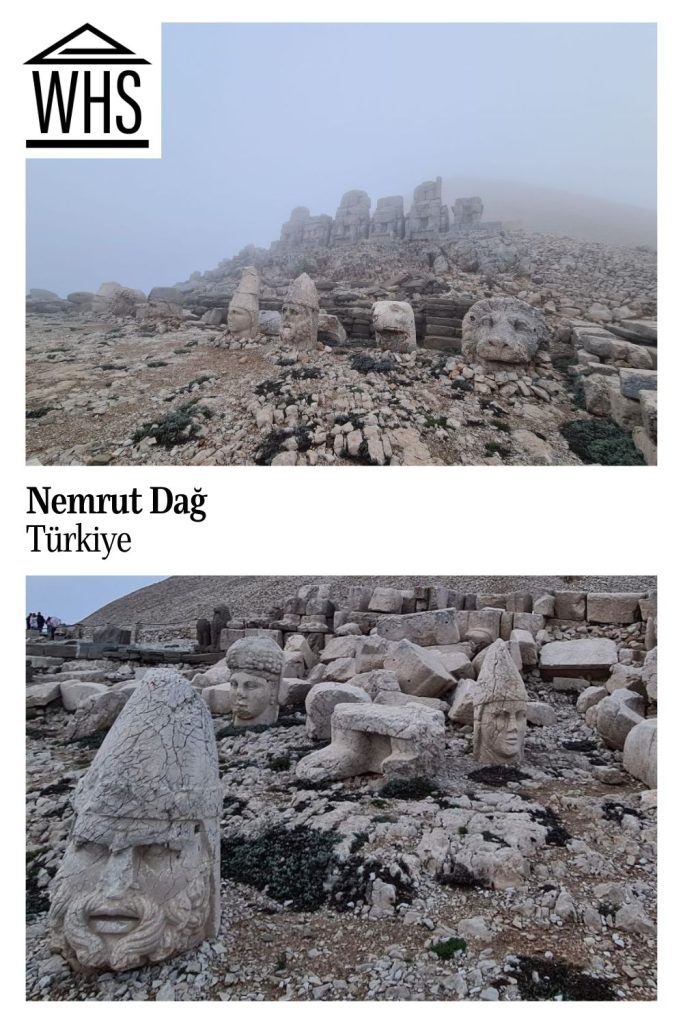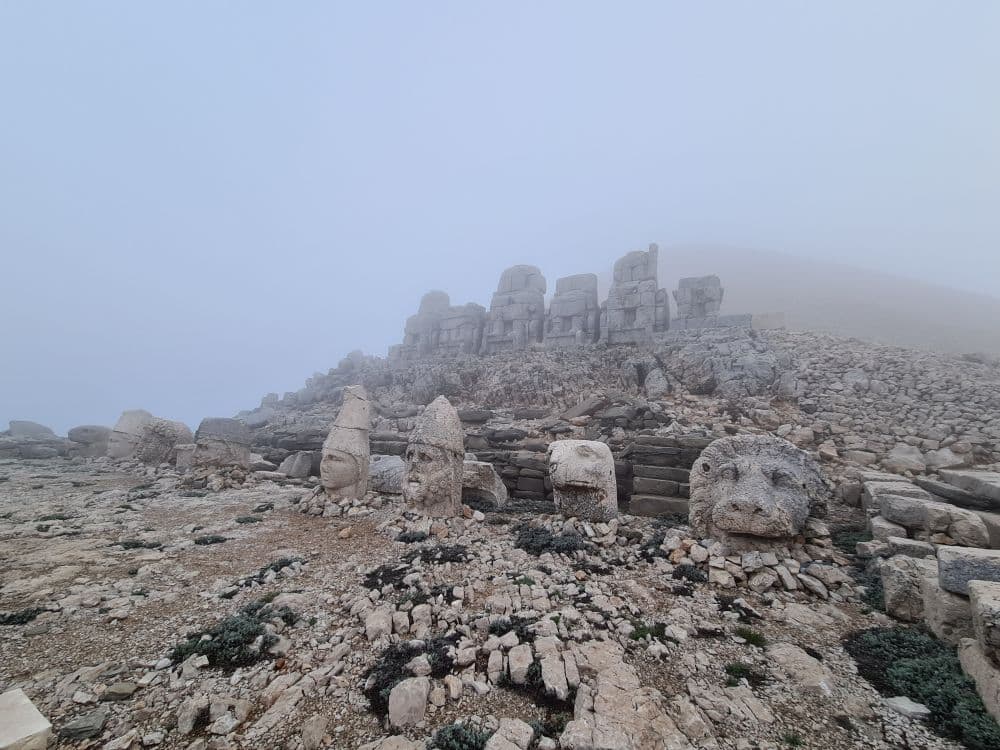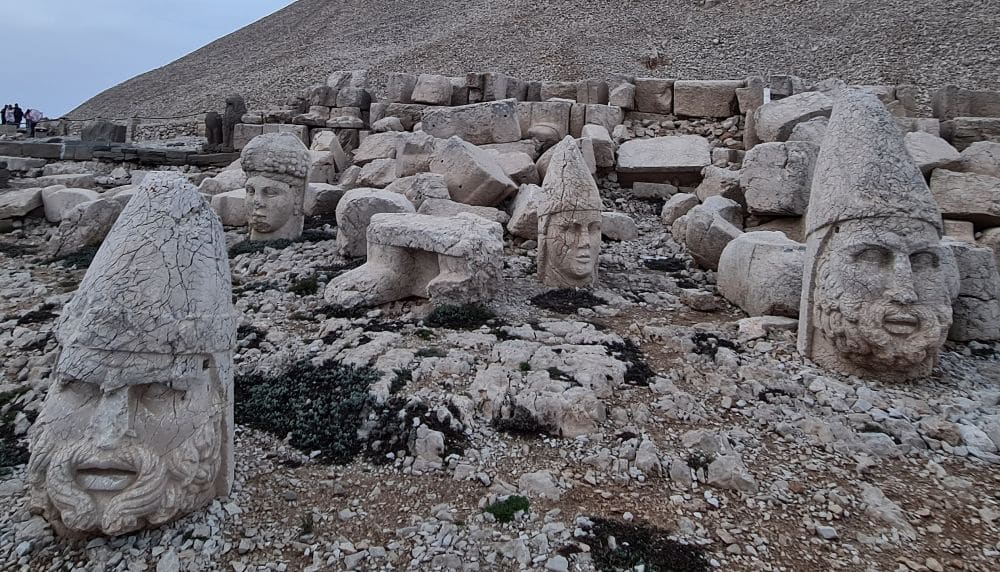Nemrut Dağ
By Maria Dol
What is Nemrut Dağ?
Nemrut Dağ (Mount Nemrut) is one of the most impressive places I have visited. It is located in the southeastern part of Türkiye, in the province of Adıyaman, and reaches an altitude of 2,134 metres (7,000 feet). At its summit is the tomb of King Antiochus I Theos of the ancient kingdom of Commagene, surrounded by colossal stone statues.

Disclosure: This article contains affiliate links. Making a purchase through an affiliate link will mean a small commission for this website. This will not affect your price. Privacy policy.
Why is Nemrut Dağ a UNESCO World Heritage site?
Mount Nemrut was inscribed on the UNESCO World Heritage List in 1987 for its outstanding archaeological and cultural value. The complex is a unique combination of Greek, Persian and Armenian elements, symbolising Antiochus I’s ambition to unite East and West through religion and culture.
At the same time, UNESCO calls the tomb “a unique artistic achievement.” During the reign of Antiochus I (70-31 BC), landscaping the mountain was “one of the most colossal undertakings of the Hellenistic period,” given that the stone blocks weighed as much as nine tons.

What can you expect on a visit to Mount Nemrut?
Visiting Nemrut is an experience that is difficult to describe in words. The first thing I felt is how remote and majestic the landscape is. The climb to the top is steep and rocky.
At the top I was greeted by colossal stone figures – Zeus-Oromazdes, Antiochus, Apollo-Mithras-Helios-Hermes and Heracles-Artegnes. Remarkably, the heads of these statues have fallen from their bodies and lie on the ground in an almost surreal composition.
The eastern terrace is the place to be at sunrise. With the first rays of the sun, the ancient figures turn golden and the view of the surrounding mountains is like something otherworldly. The western terrace, where I watched the sunset, is equally captivating – the colours of the sky and the rocks create an almost unreal landscape.
The most interesting details to note are: the bas-reliefs depicting scenes of King Antiochus shaking hands with the gods; the eagle and the lion on the two terraces, symbols of royal power; and the inscriptions left by Antiochus, which reveal his philosophy and his quest for immortality.

Is Nemrut Dağ worth visiting?
Yes, Mount Nemrut (Nemrut Dağ) is definitely worth a visit. It is one of the most impressive archaeological and natural wonders of Türkiye. Here are a few reasons to visit Nemrut:
- Historical significance: At the top of the mountain is the tomb sanctuary of King Antiochus I Theos of the ancient kingdom of Commagene, surrounded by colossal stone statues of gods and lions.
- Stunning views: The sunrises and sunsets from the top of Nemrut are breathtaking. Visitors often say that these moments are among the most memorable of their travels.
- Unique atmosphere: The combination of ancient history, mystical statues and natural beauty creates a feeling of travelling back in time.
If you are looking for a unique trip in Türkiye, away from the mass tourism, Mount Nemrut should be on your itinerary. The majestic statues, mystical atmosphere and breathtaking sunrises promise an unforgettable experience. Book your flight to Adıyaman, lace up your hiking boots and witness one of the most remarkable testimonies to human creativity.
What sorts of travellers would like Nemrut?
History and archaeology enthusiasts and any travellers interested in ancient civilisations and mystical places would enjoy visiting Mount Nemrut. So would photographers in search of dramatic sunrises and sunsets, as well as adventurers and off-the-beaten-path enthusiasts.
A visit to Nemrut is not just a tourist stop – it is an emotion that will stay with you forever. Standing among the fallen heads of the gods, you feel the power of time and the human ambition to leave a mark. Neither photos nor stories can fully convey the magic of this place. You have to see it for yourself.

Tips for visiting Mount Nemrut
Choose the season carefully. The best months to visit are late April to late October. In winter, the road to the summit is usually closed due to snow.
Be prepared for the cold: Despite the hot Turkish summer, it can be very cold at the summit. Be sure to bring a jacket and hat, especially if you plan to stay for the sunrise or sunset. Wear comfortable shoes or hiking boots; the paths are steep and rocky.
Hire a local guide. This will give you a deeper understanding of the symbolism of the complex.
Plan an overnight stay. It is best to stay in the village of Karadut, from which early transfers to the summit depart.
There are a number of UNESCO sites in Türkiye that aren’t too far away. If you’re driving, you could add them to your itinerary as well. Hire a car from the airport in Istanbul, Ankara or Antalya.
If you’d prefer not to travel independently, a variety of companies offer multi-day tours from Cappadocia or Istanbul; here are some of the tour options.
Where is Mount Nemrut?
It is most convenient to fly from Istanbul or Ankara to Adıyaman, then rent a car or take a transfer. Nemrut is about 85 km (53 miles) from Adıyaman, which takes about 1.5 hours by car.
Karadut or Kâhta can be reached by bus, but for the final stage to the summit you will need a private transfer or an organised tour.
For more information about Nemrut, its opening hours and admission fees, see this website.
Have you been to Mount Nemrut? If so, do you have any additional information or advice about this UNESCO World Heritage site? Please add your comments below!
